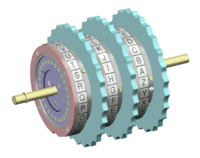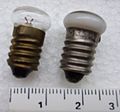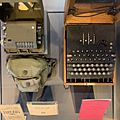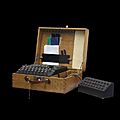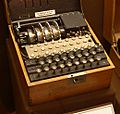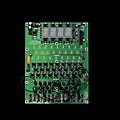Enigma (machine) facts for kids
The Enigma machine was a special device used to send secret messages. It was created in Germany by Arthur Scherbius before World War II. Think of it like a super-smart typewriter that scrambled your words so only certain people could read them. It was a type of cipher machine, which means it changed letters in a message to make them look like random letters.
When you typed a letter on the Enigma, a different letter would light up. These choices weren't random at all! They were decided by a set of spinning wheels inside the machine called rotors. Every day, these rotors were set up in a different way. Each time you pressed a key, the rotors would turn, changing how the next letter would be scrambled. This made the codes very hard to break.
Contents
Breaking the Secret Code
The secret messages sent using the Enigma machine were first cracked by the Polish Cipher Bureau. They started working on it in December 1932. The Polish experts even designed special machines to help them break the Enigma codes. As time went on, the Germans made their Enigma machines more complex, making it harder to unscramble the messages.
In July 1939, the Polish code-breakers shared their amazing work with French and British spy agents in Warsaw. They even gave each country a Polish-built Enigma machine. This meeting was super important! It gave the British a vital head start for their own code-breaking efforts at Bletchley Park.
Gordon Welchman, who worked at Bletchley Park, later said that their team, called "Hut 6 Ultra," wouldn't have succeeded without what they learned from the Poles. They learned about the German military Enigma machine and how it was used.
The Ultra Team and Alan Turing
As the war continued, the Germans made their codes even stronger. So, a new secret code-breaking team called "Ultra" was formed in Britain. This team was led by a brilliant English mathematician named Alan Turing. He developed an even more advanced machine that could decipher the secret naval Enigma messages by 1940.
The British code-breakers at Bletchley Park solved a huge number of Enigma messages. They turned the scrambled messages back into plain, readable text and gave this vital information to military leaders.
The information gained from breaking these codes was a massive help to the Allied forces during the war. The Ultra team also broke other German, Italian, and Japanese codes, including those used by the German High Command.
Sometimes, mistakes made by German operators helped the code-breakers. For example, some mistakes helped crack the codes used by the Luftwaffe (the German air force). Also, when the British captured important code tables and even an Enigma machine from a German submarine, it helped them break the Navy's codes.
Enigma Today
On July 15, 2011, Queen Elizabeth II visited Bletchley Park. The original Enigma machine is kept there in a museum. She paid tribute to all the people who worked there, as their secret work helped to shorten World War II by breaking the codes of Nazi Germany.
Images for kids
-
Military Enigma machine, model "Enigma I", used during the late 1930s and during the war; displayed at Museo Nazionale Scienza e Tecnologia Leonardo da Vinci, Milan, Italy
-
The Enigma stepping motion seen from the side away from the operator. All three ratchet pawls (green) push in unison as a key is depressed. For the first rotor (1), which to the operator is the right-hand rotor, the ratchet (red) is always engaged, and steps with each keypress. Here, the middle rotor (2) is engaged, because the notch in the first rotor is aligned with the pawl; it will step (turn over) with the first rotor. The third rotor (3) is not engaged, because the notch in the second rotor is not aligned to the pawl, so it will not engage with the rachet.
-
Heinz Guderian in the Battle of France, with an Enigma machine. Note one soldier is keying in text while another writes down the results.
-
Surviving three-rotor Enigma on display at Discovery Park of America in Union City, Tennessee, U.S.
-
A four-rotor Kriegsmarine (German Navy, 1. February 1942 to 1945) Enigma machine on display at the U.S. National Cryptologic Museum
-
A four-rotor Kriegsmarine Enigma machine on display at the Museum of the Second World War, Gdańsk, Poland
See also
 In Spanish: Enigma (máquina) para niños
In Spanish: Enigma (máquina) para niños



